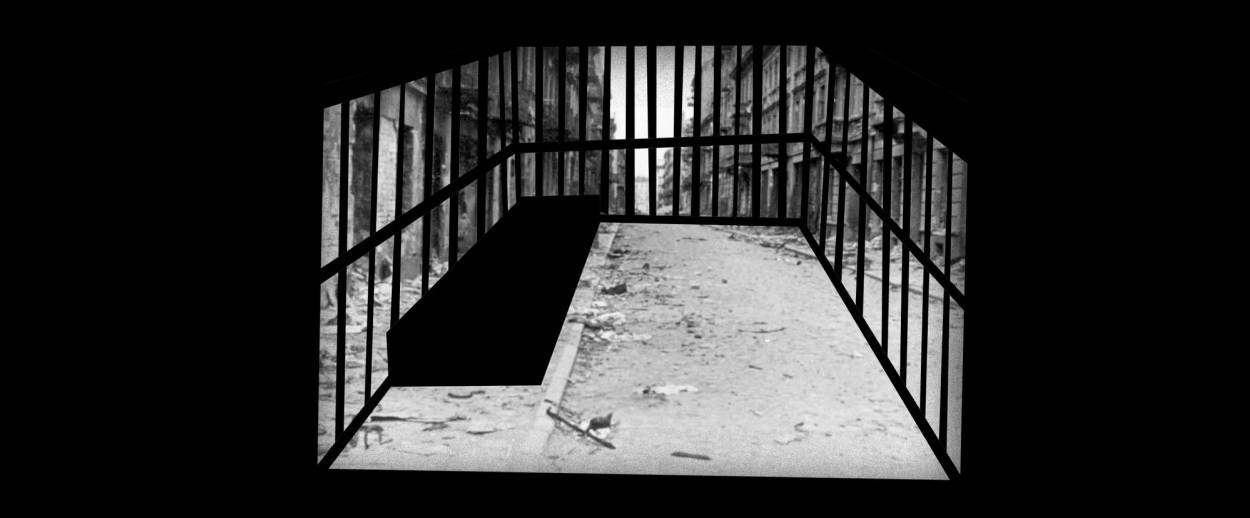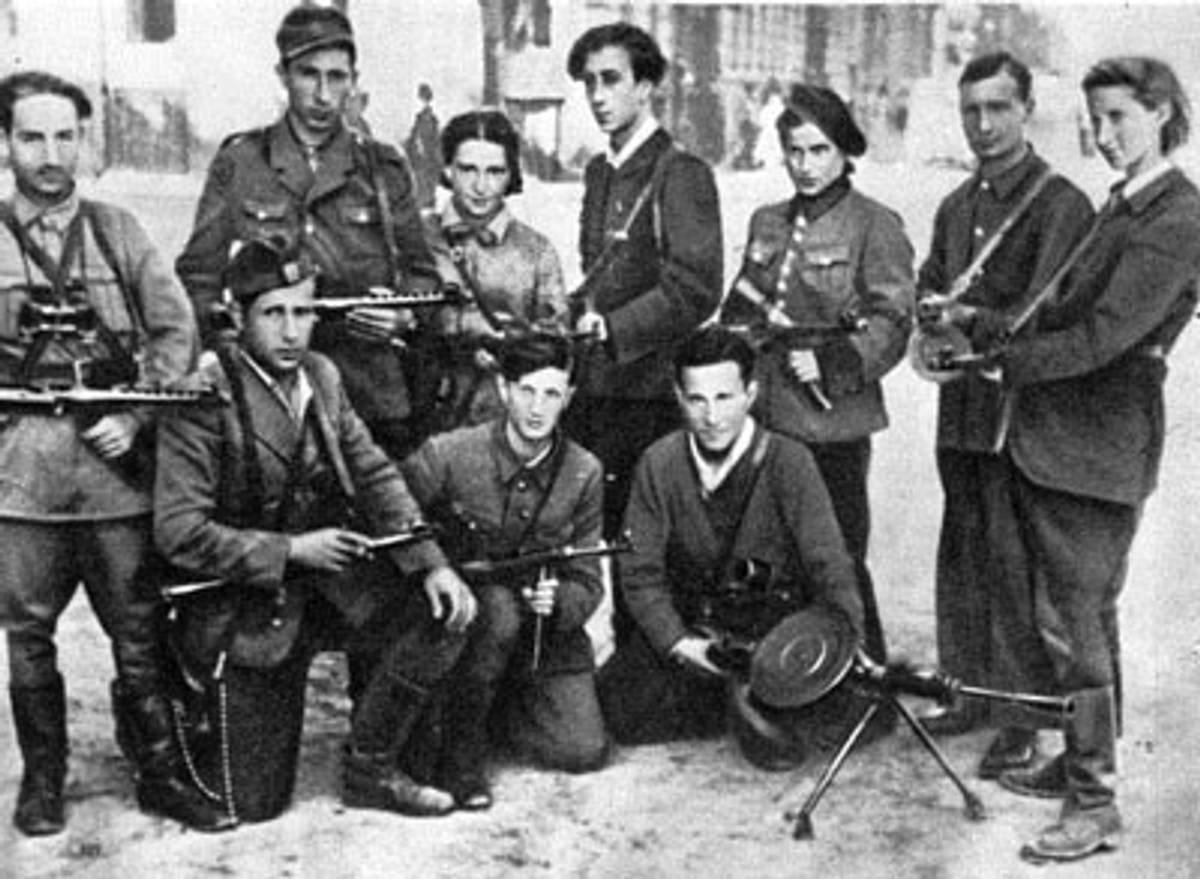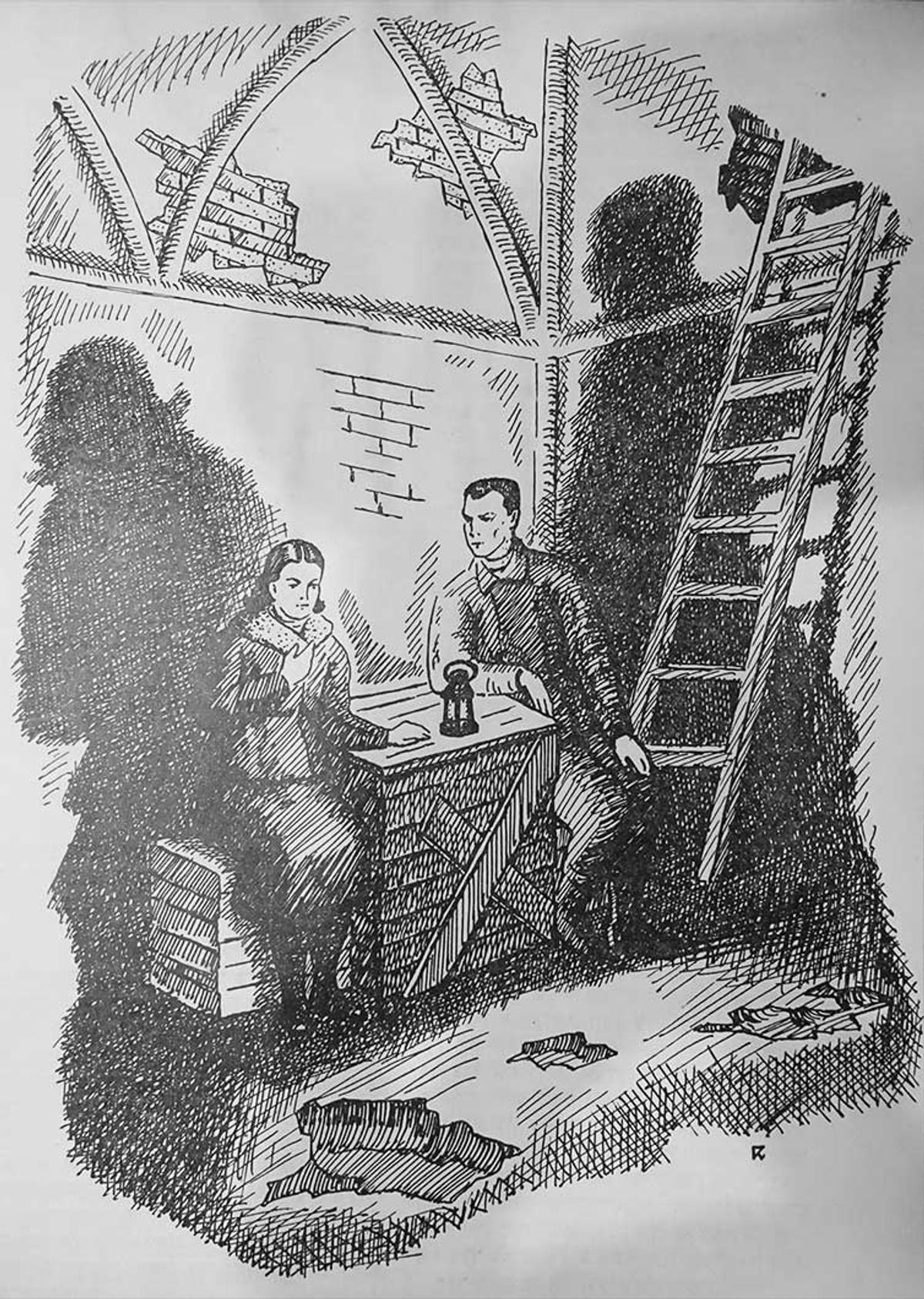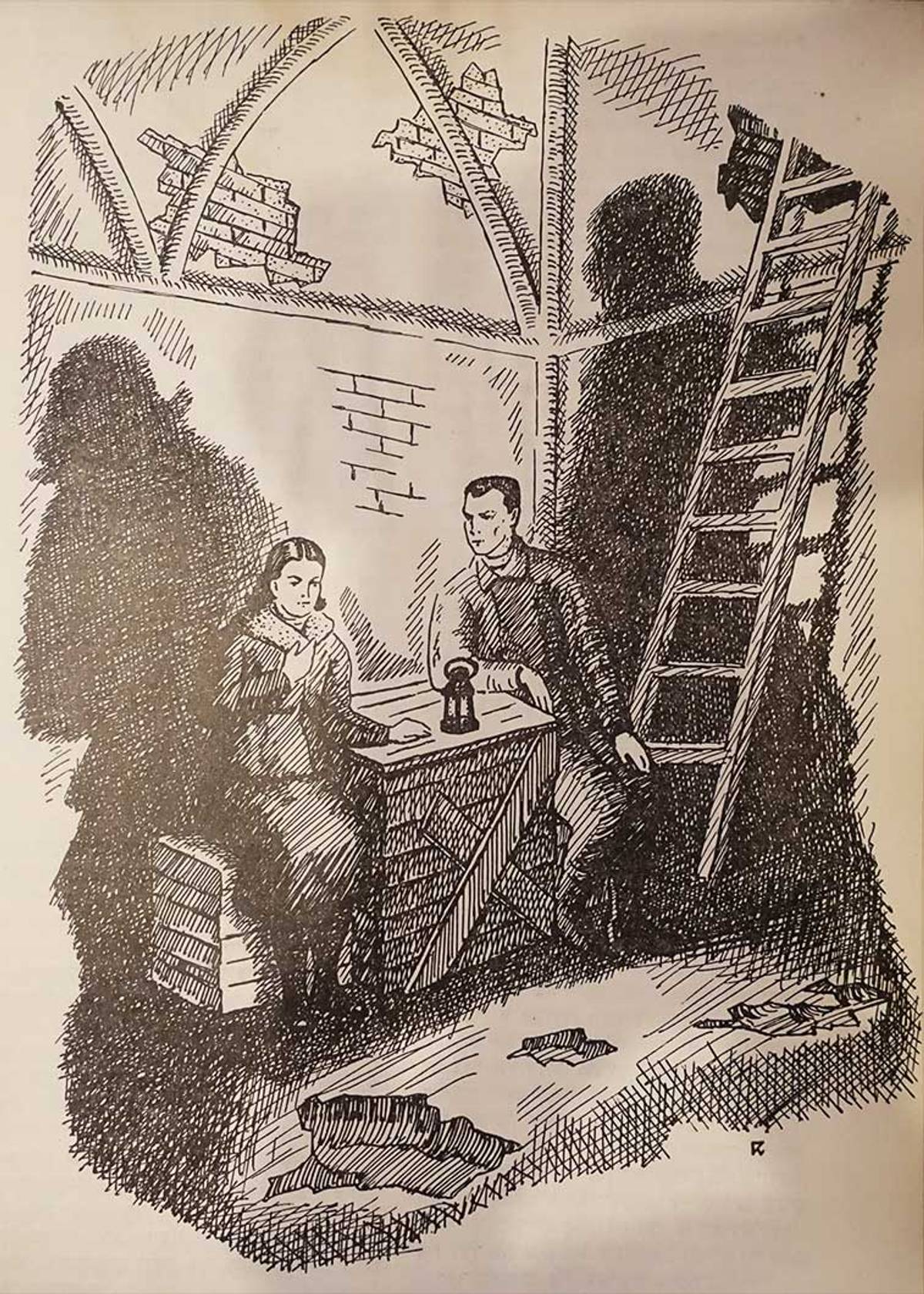How Did Itzik Wittenberg, Hero of the Vilna Ghetto, Die?
The answer defines moral views of resistance and martyrdom, and says more about the version of history being told than it does about Wittenberg himself





n July 8, 1943, Bruno Kittel, an Oberscharfuhrer in the German Security Police, drove into the Vilna ghetto and summoned Jacob Gens, the chief of the Jewish Police and the de facto head of the ghetto. Kittel—who two months hence would supervise the liquidation of the ghetto—demanded the immediate surrender of Itzik Wittenberg, the Communist commander of the Fareynikte Partizaner Organizatsye (FPO), the United Partisans Organization, the ghetto’s underground resistance movement. What exactly Kittel knew about Wittenberg was not made clear: Either affiliation, Communist or FPO, was a capital crime; either affiliation would, of course, mark Wittenberg as someone the Gestapo would be very interested in questioning.
But Wittenberg had been warned, likely via underground Communist channels, and had gone into hiding. Zenia Berkon, a member of the FPO, has said that Wittenberg hid in her small apartment, with her and her mother, and that he disguised himself with a mustache, dark glasses, and a rubber coat. Some accounts claim that Kittel was told that Wittenberg was dead.
Kittel, frustrated, arrested a ghetto policeman named Aurbach. Aurbach was also a member of the FPO—a fact Kittel was almost certainly not aware of—but was returned to the ghetto the next day, showing no signs of being tortured, and claiming he had not given up any incriminating information. Why Kittel arrested and subsequently released Aurbach has never been wholly explained: It may have been a ruse to lure Wittenberg, to demonstrate to him as well as the ghetto brass that Wittenberg was wanted only for questioning, and would be released unharmed.
In the wake of Kittel’s visit, the FPO leadership went on high alert. The Nazis’ reaction to real or even suspected underground movements—especially since the Warsaw ghetto uprising earlier that year—was scorched earth: They would raze villages, murder entire populations. The FPO had thus far successfully maintained a low profile; they had eschewed open and armed resistance for covert operations of sabotage, smuggling, and communication; even inside the ghetto, relatively few Jews were aware of its existence. But if the Germans had somehow learned of the FPO and its activities, the destruction of the ghetto could very well be at hand; and if that was, in fact, the case, the FPO—which from its inception in January 1942 had committed to revolt when, and only when, the liquidation of the ghetto was imminent—would launch the uprising. They would not, in the language of their manifesto, be led “like sheep to the slaughter.”
But in the following week, there were no further demands or arrests, no signs of German mobilization, no further inquiries about Wittenberg, either from the Jewish authorities or the German; the matter seemed to be forgotten. There was also encouraging intel: It emerged that Wittenberg had been identified by a Lithuanian Communist named Kozlowski, who had been arrested and tortured by the Gestapo. This meant that Kittel had wanted Wittenberg because he was a Communist, not because he was the leader of the FPO—which, for now, remained underground. Life in the ghetto resumed.
***

ne week later, on July 15, 1943, ghetto chief Jacob Gens summoned the leaders of the FPO—Wittenberg, Abba Kovner, Abrasha Chwojnik, and Chenia Borowska—to a meeting at his office in the Judenrat building, Gens’s headquarters. Such a meeting was not particularly unusual or suspicious: Gens and the FPO maintained close, if covert and often tense, contact—if Gens did not support the FPO outright, he did so tacitly, turning a blind eye to their “illegal” activities—and Gens would often host unofficial nighttime meetings at his office or apartment.

Kovner has said that he and the other FPO leaders were of the impression that the meeting had no particular agenda, that whatever Gens wanted to meet about had nothing to do with Wittenberg. Had they suspected otherwise, Kovner said, they would not have gone, or, at the very least, Wittenberg certainly would not have. But another member of the FPO, Abrasha Krizowski, friend of Wittenberg and a fellow Communist, has claimed that it was Wittenberg who had scheduled the meeting—Krizowski said that Wittenberg wanted to touch base with Gens, to clear the air. Given the fractured and overlapping allegiances and lines of communication—Wittenberg and Krizowski were affiliated with both the Jewish underground and the Communist underground, two organizations without established and trusted means of sharing information—it is possible that Kovner simply did not know that Wittenberg had initiated the meeting.
For unknown reasons, Gens postponed the meeting, then postponed it again. By the time the five gathered in Gens’s office, it was close to midnight.
The meeting seems to have begun congenially; the atmosphere, according to those present, was that of a friendly get-together. Kovner has said that Gens poured drinks, that there were toasts and l’chaims. But at some point, likely not more than 20 minutes after the FPO leaders had arrived, German (or, in some accounts, Lithuanian) soldiers entered the room. (According to some accounts the soldiers were escorted by Salek Dessler, Gens’ deputy, and easily the most reviled and least trusted man in the Vilna ghetto.) Kovner testified in the Eichmann trial about Wittenberg’s arrest:
A side door in the office of Gens opened and SS men appeared in the doorway with submachine guns pointing at us. They ordered us to stand up and asked: “Who here is Wittenberg?” Nobody answered. Then Gens pointed to Wittenberg and said: “That is Wittenberg.” They bound him in chains and removed him with their submachine guns.
The other three FPO leaders remained in the room with Gens, who had, it was now clear, orchestrated Wittenberg’s arrest. Kovner reported the following exchange: “We said to Gens, ‘You disgraceful traitor—we shall meet again.’ Gens replied, ‘I am not responsible. One of your men was caught by the Gestapo, passed on the name of Wittenberg, and I was obliged to deliver him; otherwise, others would have paid for him with their lives.’ ” According to Krizowski—who was not inside the room—Chiena Borowska spat in Gens’ face. (However, in Borowska’s own, fairly detailed account, she makes no record of this.)
The German/Lithuanian soldiers escorted Wittenberg from Gens’ office to the Judenrat courtyard, then started toward the ghetto gate, which was a couple hundred meters away. But they were spotted almost immediately by the FPO, who had set up vantage points near the Judenrat building. (Accounts disagree on whether this was standard FPO protocol—i.e., if every meeting with Gens mandated “backup,” or if such measures were taken only because of lingering tension between Gens and the FPO. And some FPO members have claimed that the organization’s partial mobilization was in response to reports that Salek Dessler had been spotted leaving the ghetto and returning with German/Lithuanian soldiers.)
The FPO set upon the soldiers, and freed Wittenberg. Joseph Harmatz has said that he and two other partisans “fell on the police and cut off his handcuffs,” and that the rescue “was very quick.” According to Harmatz, there was very little commotion. Rachel Korzak, another member of the FPO, offers in her memoir a much more dramatic version:
In the courtyard the tumult increased. The police were running with lanterns in their hands. At this moment I didn’t care. I ran to the gate, pushed the gatekeeper, and broke into the street. Behind me were the sounds of footsteps and shouting. I ran to Rudnicku 7 and shouted loudly: “Comrades! They captured the commander! Everyone to the gate! Free him!” In the courtyard windows opened. People who had been woken up stuck their heads out [of the window] and asked what’s going on. But there was no one to answer them. All ran and charged to the other side of the street, crying: We will not give up our commander!
Itzik heard the cry. He understood to move his legs quickly. He spurted from his captors and ran towards the voices. The Gestapo chased after him. But immediately [FPO members] stopped them, fell on them, hit them. We could hardly discern in the dark the figures of our fighters who struggled with the guard. And afterwards nothing was seen except tremendous rushing; at the head ran Itzik, free.
Others accounts are more or less dramatic, more or less exciting. Regardless, in the breaking hours of July 16, 1943, Itzik Wittenberg, commander of the FPO, member of the Communist underground, became a fugitive from the Gestapo, and, by proxy, from Gens and the Jewish ghetto government.
***

ess than an hour after Wittenberg had been freed, Gens called a ghetto-wide meeting in the Judenrat courtyard, the ghetto’s de facto public square. Such a meeting was unprecedented, and ghetto residents began to panic. Rumors of an aktion (purge), even of liquidation, began to spread. It was by now around 1 o’clock in the morning.
Gens addressed the assembled from the balcony of the Judenrat building. He announced that the Gestapo had identified Itzik Wittenberg as an underground Communist and had demanded his immediate surrender. If—so Gens relayed the Gestapo’s warning—Wittenberg was not delivered, alive, within the hour, the ghetto would be destroyed. Mark Dworzeski, a prominent survivor-historian, paraphrased Gens’ speech:
In the city a Polish communist, Kozlowski, was captured. While being interrogated he revealed that he maintained contact with a certain Wittenberg, who runs a secret printing press in the ghetto that prints leaflets for the Communist party in the city. The Gestapo demands Wittenberg. They have given an ultimatum to the ghetto police to deliver Wittenberg within one hour and if not—the German tanks will enter the ghetto; they will raze the ghetto streets with bombs. … What should now be done? Should the entire ghetto population be sacrificed for the sake of one, or should the one be given over in order to save all?
Was Gens telling the truth? Did the Gestapo, in fact, issue such a threat? Did Gens exaggerate or invent? Was the ghetto actually in danger of being destroyed? It is impossible to know. There are no records of German orders to this effect. At no point over the course of the night was there any indication that the Germans were mobilizing forces; at no point over the course of the night did any Germans even re-enter the ghetto.
But this question—whether Gens was accurately relaying German demands or partially or wholly inventing them—is moot, because Gens delivered his speech not in order to inform the ghetto population but in order to influence and manipulate them. Regardless of whether the ghetto’s imminent destruction was actually in the balance, what Gens did was primarily tactical: He persuaded the ghetto inhabitants that their lives depended on the capitulation of one man.
The gathering, unsurprisingly, turned violent. To some extent this was encouraged by Gens, who had summoned the shtarkers—quasi-criminal characters the Judenrat relied on in emergency situations; in other words, muscle for hire. The mob—riled up by Gens, fueled by the shtarkers, and condoned or even joined by the Jewish police—armed themselves with stones and clubs. There are reports that the Jewish police distributed revolvers.
The mob, carrying the slogan “one or 20,000,” began to tear the ghetto apart searching for Wittenberg. Dworzeski writes that he helped hide Wittenberg’s wife and child, who were afraid they’d be arrested, in a melina (hidden compartment). They could hear the Jewish police outside:
Jews inside the house, inside the melinas, listen! Help catch Wittenberg. Save the ghetto! Wittenberg is disguised in women’s clothing. In a black dress, and a light kerchief. Look in the house, in the melinas: Perhaps he is among you? Jews, save yourselves!
But Wittenberg had barricaded himself inside an FPO safe-house (the precise location of which is disputed), and the mob, frustrated and panicked, swarmed outside the FPO’s headquarters, a narrow, wooden house. They demanded Wittenberg’s immediate surrender and threatened to rush the building. Armed FPO members were ordered to prevent anyone from entering.
The FPO leadership attempted, unsuccessfully, to placate the crowd. Kovner had printed an appeal that called on the Jews in the ghetto to rise up in the face of imminent destruction—“as Wittenberg’s arrest was nothing but a pretext for the subsequent liquidation of the ghetto.” (The appeal was not distributed, and, after the war, Kovner admitted that what he had written was baseless, that he had had no reason to suspect an impending aktion.) The overwhelming majority of the ghetto population, the FPO realized, was against them.
The crowd seethed: The reported deadline—the deadline many in the ghetto believed their lives depended on—had passed, and Wittenberg had not yet been found, had not yet been persuaded or forced to surrender.
The standoff turned violent. A man named Shapira, widely considered by surviving FPO members to have been a provocateur, fired shots; some accounts claim the FPO returned fire. One member of the FPO was struck in the head with an ax. (During an interview on the documentary Partisans of Vilna, he bows his head to display his scar, a jagged slant that traverses crown to brow.)
At least eight FPO members were arrested and jailed. A policeman was shot and wounded. Vitka Kempner recounts her comrades’ mothers shouting at their children: “How can you sacrifice us for this nonsense? There is a chance that we will stay alive.” Abba Kovner’s poem Today is the Sixteenth of July contains the verse: “On the dawnless night / of the sixteenth of July / a wretched horde is ready / to eat you alive.” The ghetto was on the brink of a civil war. Gens sent to the FPO a series of delegations—uniformed policemen at first, then more-trusted ghetto leaders—in order to negotiate Wittenberg’s surrender.
According to Abba Kovner, who claimed to have led the negotiations on behalf of the FPO, Gens’ delegates successfully persuaded the FPO of two critical facts. First, that the Germans knew only about Wittenberg—i.e., they had identified Wittenberg as a Communist, and only as a Communist, not as a leader of the FPO—and remained unaware of the FPO’s existence. And second, that there was no impending aktion—that is, if Wittenberg were to surrender, the ghetto, for the foreseeable future, would not be in danger. Kovner further said that Gens relayed a promise that everything possible would be done to secure Wittenberg’s release, provided he could withstand the torture. According to other accounts, Gens (or, according to some, Dessler) explicitly guaranteed Wittenberg’s release.
Negotiations between Gens and the FPO continued; the Gestapo’s deadline was repeatedly extended, from 3 a.m. to 6 a.m. to 10 a.m. (Again, the Gestapo’s role in all this is unverified—their commands were conveyed, perhaps faithfully, perhaps not, by Gens/Dessler. One survivor relates that Dessler was constantly and with increasing urgency suggesting to the FPO that the Germans were mobilizing tanks, which was almost certainly not true.)
The decision the FPO now faced—surrender their leader or put the entire ghetto at potential risk—in many respects mirrored Gens’ central moral quandary as ghetto chief—namely, should a few be sacrificed in order to save many? Gens was always explicit that his goal, as leader of the ghetto, was survival, was staving off extinction as long as possible, even if that meant the concession of lives. Judgment of Gens has hinged on this question: Is it morally acceptable, or perhaps even morally incumbent, to let a few die in order to save many?
This sort of moral equation—the decision the FPO was forced into was the same decision Gens and the Judenrat had been continually forced into since the ghetto’s inception—is a theme invoked often in the literature of the Vilna ghetto. In Leslie Epstein’s King of the Jews, a semi-satirical novel about an imaginary ghetto, the Edmund Trilling Brigade (a stand-in for the FPO) must decide whether to sacrifice Lipsky (a stand-in for Wittenberg). They vote to surrender him, and Lipsky bursts into tears:
I’m not crying for myself. I don’t care about having to die. Poof! One more Jew! I’m crying for Trilling and Szypper and Professor Zygmunt because they gave up their lives. For what? So that we could behave exactly like their great foe, the Judenrat! Hand one over, we’ll save many! … There is something in history that makes all men act the same!
The FPO leaders decided that Wittenberg must surrender himself to the Germans. How exactly this decision was reached, who pushed it through, and how reluctantly the decision was accepted by FPO brass, is disputed. Some accounts claim that the decision was first reached by representatives of the Communist underground, and, subsequently, the FPO fell in line. Others claim the decision was reached independently by both the Communist underground and the FPO. It is also unclear whether Wittenberg was present when the decision was made, or if he was informed afterward. Regardless, it was ultimately the opinion of the FPO and the Communist underground, not to mention Gens, the Judenrat, and the majority of the ghetto population, that Wittenberg should surrender himself.
But Wittenberg refused. He left the meeting place and, disguised as a woman, wearing a dress and a kerchief and holding a basket, went into hiding. He was briefly caught by ghetto residents but escaped—some accounts claim he fired warning shots from his revolver—and went to an FPO stronghold, where he met with FPO leaders to discuss his fate.
Wittenberg was initially adamant: He argued that there was no known case of a resistance movement surrendering their commander, that surrendering would be detrimental to the FPO’s cause. Kovner recounts that Wittenberg was struck by a “fear that [the FPO] should not be stamped into history as frivolous.” Wittenberg proposed that he commit suicide: This was rejected, as the Gestapo had demanded (or Gens claimed that the Gestapo had demanded) Wittenberg alive. Escaping to the forest was rejected for similar reasons. One of the FPO leaders suggested that the entire head staff commit suicide, an idea which, according to some accounts, Wittenberg himself rejected, as it would damage the organization.
Wittenberg then proposed that the FPO begin the revolt, that they launch the uprising they’ve been readying and training for since the early months of the ghetto. But the FPO brass demurred: They had resolved to fight only when liquidation was imminent, and, more important, they did not have the ghetto’s support—in order to fight the Germans they’d first have to fight Jews.
Still, Wittenberg was their commander; Kovner relates that the decision whether to launch the uprising or not was, ultimately, Wittenberg’s. Kovner has claimed that he told Wittenberg, “Give the order, everyone is ready, everyone is at his post. Give the order and we’ll fight.” Wittenberg, Kovner said, did not give the order.
Eventually, Wittenberg capitulated: He would surrender to the Gestapo. (Zenia Berkan, an FPO member, claimed that Wittenberg was forcibly turned in, but later admitted to not have been present at the meetings.) Many accounts relate that Wittenberg stood and handed Kovner his revolver before exiting.
On the morning of July 16, 1943, Itzik Wittenberg, whether on his own accord, or compelled, or something in between, met with Gens near the Judenrat building, where a car was waiting. He was taken to the Gestapo headquarters, a couple kilometers outside the ghetto, and the next day he was dead. Nissan Reznik, an FPO member, ends his account thus: “[Itzik said] ‘If that’s what you want, I’ll go.’ And out he went.”
***

he story of Itzik Wittenberg—the betrayed and perhaps twice-betrayed leader of the ghetto underground—has been preserved and even enshrined; it has been told and retold, in myriad forms and with various emphases. At least a dozen different plays, most prominently Joshua Sobol’s Adam, and scores of songs and poems have been written about Wittenberg. Virtually every relevant book—about the ghetto, about the partisans, about Jewish resistance, as well as many of the more-general Holocaust histories—dedicates at least a few lines to Wittenberg and the events of the night of July 16, 1943. Most memoirs written by survivors of the Vilna ghetto, even those who did not interact with Wittenberg, who had nothing to do with the FPO or Gens, speak more about Wittenberg than any other character in the ghetto (with the exception of Gens). Wittenberg has been valorized, pitied, memorialized, mythologized; he’s been a hero, a victim, a symbol; his story has been used to demonstrate the nefariousness of Gens, the impossibility of the FPO’s plight, the shortsightedness/delusion/misplaced hope of the ghetto population. It isn’t difficult to understand the appeal of Wittenberg’s story, for the poet as well as the historian. It is exciting, complex, involved: It’s got elements of resistance, authority, betrayal, partisans, politics, machinations, negotiations, mobs, manipulations and implied and actual violence.
But the narrative has a gaping hole: We don’t know perhaps the most significant part of the story—how it ends. We don’t know with certainty how—at whose hands, by what means—Wittenberg died. Based on the couple dozen or so testimonies, memoirs, diaries, histories, and interviews—the various records of those who claim to know how Wittenberg died—there are three possible scenarios.
The first scenario—which we might consider a sort of default—is that Wittenberg died in the manner one would expect a Jewish Communist prisoner in Gestapo custody to die, i.e., he was interrogated, tortured, mutilated, and, eventually, killed. In the KGB archives in Lithuania there are records of a postwar interrogation of a man named Ginzburg, a stoker in the Gestapo building, who claims that he informed the FPO that Wittenberg was murdered and cut into pieces with a saw; the same document details a similar report of M. Kamermacher, another Jewish worker employed at the Gestapo facilities. Abraham Sutzkever wrote in his memoir that “Wittenberg’s body lay in the corridor of the Gestapo building. His hair was burned, his eyes pierced and his arms, bound behind, broken.” In the restored version of The Black Book, Sutzkever even names the Gestapo agent who tortured Wittenberg: Max Gross.
The second scenario is that Wittenberg was murdered by Gens and/or Dessler, who were worried that Wittenberg might reveal damaging information to the Germans. The method of murder? In this scenario, Gens and/or Dessler slip delayed-reaction cyanide into Wittenberg’s drink before delivering him to the Gestapo; Wittenberg thus died while in custody but before he could be tortured. From the memoir of Rokhl Korczak, an FPO member:
In the afternoon some strange news reached us: Wittenberg’s soul had departed before the interrogation. He died in the morning. His corpse that was taken out from the jail was blue. The matter of his death was a serious mystery. We did not manage to smuggle the cyanide to him! After many days, our suspicion was confirmed—that Wittenberg, before he left the ghetto, was poisoned by Gens and Dessler, who were worried that he might endanger their standing.
The third and most widely espoused scenario is that Wittenberg killed himself by willingly ingesting cyanide that Gens and/or Dessler had provided for him. This scenario has, in fact, two versions: (1) Wittenberg took a delayed-reaction cyanide pill while still in the ghetto and died some hours later, after he’d been apprehended; and (2), Wittenberg hid on his body a “regular” (not delayed-reaction) cyanide pill—one account has him hiding the pill in his ear—which he ingested in the Gestapo building and which killed him more or less instantly. In either case, Wittenberg’s death occurs outside the ghetto and before he could be tortured; the main difference between these versions is whether the cyanide pill was delayed-reaction or not. Most accounts seem to agree that it was. Perhaps noteworthy is the testimony of Brayna As, a survivor who claims that though Wittenberg was in possession of poison, he chose, for unspecified reasons, not to take it. According to As, Wittenberg’s body was discovered in the Gestapo building showing “signs of terrible torture.”
This third scenario is the one put forth unhesitatingly by Yitzchak Arad in Ghetto in Flames, the most respected and frequently cited history of the Vilna ghetto. “[Wittenberg] had poisoned himself with cyanide of potassium,” writes Arad, “which he had brought from the ghetto. It had been given to him by Gens at their last meeting, before he was surrendered.” Arad continues:
Wittenberg decided to take his life when he realized that he would not leave German hands alive, and out of fear that he would not be able to endure the interrogations and torture, would break and give the names of his underground comrades. He gave no information to the Security Police before he committed suicide, and none of his friends in the ghetto underground or outside was arrested in the wake of his detention.
(The sources, though at odds with one other, are for the most part remarkably assured; in fact, I’ve seen only one account, that of Nusia Dlugi, a survivor and FPO member, that allows for any uncertainty: “The next day in the morning the news came that Wittenberg is dead. Exactly what happened at the Gestapo isn’t known—whether he was badly tortured, whether he died immediately. Others say that Dessler or Gens poisoned him while he was still in the ghetto or that he had the poison with him. But as far as I know he did not have any poison on him.”)
It’s sometimes the case that, with the passing of however many years, a historical disagreement may be decided; evidence may emerge that will show this or that version of to be correct (or, more likely, incorrect), and we are able to arbitrate, to discard accounts, to undo the transmutation of hearsay into history. The disagreement over Wittenberg’s death is not a case like that: None of these three versions has been discredited or validated.
There is no conclusive evidence in any direction; what evidence there is, is almost always speculative.
There is no known German record of Wittenberg’s death. There are no reliable eyewitnesses who saw Wittenberg’s corpse, tortured or not, in spite of the KGB records, which are notoriously unreliable. We have no testimony—not second-hand, not third-hand—that Gens and/or Dessler admitted to poisoning Wittenberg or admitted to providing Wittenberg with the poison. (Neither Gens nor Dessler survived the war.) And no FPO member—many of whom, like Abba Kovner, had relatively intimate knowledge of the events in question—has ever claimed to have provided Wittenberg with poison. (Many FPO members claim, in memoirs and interviews, that they had wanted to get Wittenberg the poison, and some say that they had tried to. These attempts have never been clarified.)
In a 1983 letter to Professor David Roskies, Abba Kovner wrote that “Arad’s version is close to the truth … according to all the evidence we were able to collect at that time, the Gestapo agents never got to torture Wittenberg.”
But the evidence Kovner is referring to has never been elaborated on. And Kovner, who testified or was interviewed about the Wittenberg affair at least half a dozen times, was far from consistent. In one interview he stated that Wittenberg was tortured, that Wittenberg’s mutilated corpse—with broken arms and gouged-out eyes—was discovered the morning after his arrest.
Many Holocaust history books like Lucy Dawidowicz’s War Against the Jews and Isaiah Trunk’s Judenrat sidestep neatly the entire issue by being vague and nonspecific: They record that Wittenberg was brought to the Gestapo building “where he perished,” or was “found dead,” or expired in a similarly nonparticular fashion.
Perhaps this seems like a largely academic distinction—Wittenberg died by cyanide, or he was tortured; he was killed by the Gestapo, or he was killed before the Gestapo could kill him; what difference does it make? Either way, a tragic death.
What does Wittenberg’s death—and, in turn, Wittenberg himself—stand for?
But the details of Wittenberg’s death (the final image of his body, how he succumbed, who was responsible) inform the narrative of his death (hero/victim/traitor/betrayed), which, in turn, informs the meaning of his death. The at-odds “versions” of Wittenberg’s final hours are not alternative histories of Wittenberg’s death as much as competing narratives and competing moralities. Death by cyanide is relatively quick and painless; the Wittenberg who died thus avoided torture, mutilation, humiliation, degradation; he frustrated the Gestapo’s ambitions until the very end; he died above suspicion of divulging information. The tortured Wittenberg is a mutilated carcass: a symbol of the Gestapo’s reach and power. The two Wittenbergs stand as opposing answers to the question: What does Wittenberg’s death—and, in turn, Wittenberg himself—stand for?
***

istory in the Soviet Union had little to do with history; accounts of the past either conformed to Soviet ideas and ideals or were effaced. Wittenberg, a fallen Communist partisan, was posthumously recognized as a Soviet hero, an icon—after the war, a street in Vilnius’ Old Town was named for him. Via expurgation, revision, suppression, censorship, and promotion of quasi-propagandistic literature, Itzik Wittenberg was redacted into an outstanding example of Soviet courage.
In 1944, a few months after Vilnius was liberated, newly installed Soviet authorities launched an investigation into the betrayal of Wittenberg. As there were survivors, in particular partisans, who were in danger of being implicated, the poet Abraham Sutzkever hid 17 pages from the diary of the ghetto librarian Herman Kruk (who did not survive the war), because they contained, according to Sutzkever, a “sensitive issue.”
The diary of Kruk—one of the only nonpartisans who maintained close relationships with both Gens and FPO leaders—is one of the few significant Vilna ghetto sources written during, not after, the war, and is by far the best entrée we have into the characters and politics of the ghetto. Those 17 pages, which date from July 15, 1943, to Sept. 27, 1943, almost certainly contain clarifying details of Wittenberg’s death. But those pages have never been found; their contents remain unknown. This amounts to a kind of indirect Soviet censorship.
In the late 1960s, Masha Rolnik, who as an adolescent had survived the Vilna ghetto, published her diary, I Must Tell, in the Soviet Union. The book garnered considerable attention: I Must Tell was one of the few available Holocaust documents available in the U.S.S.R.; Rolnik became known as the Anne Frank of Lithuania.
In I Must Tell, Rolnik writes, matter-of-factly, that Wittenberg was poisoned with cyanide, and Arad, the prominent Vilna ghetto historian, and others have cited her book as a primary source. But there are issues regarding the authoritativeness of I Must Tell. In July 1943 Masha Rolnik was 14 years old and in no position to know what was clearly privileged information—at best, her diary is a reflection of whatever the prevalent rumor in the ghetto may have been. Further, Rolnik’s diary is not really a diary: Rolnik’s original diary, what she recorded while in the ghetto, was left behind and never recovered. What was ultimately published is an attempted reproduction, a sort of memoir in diary form, that she wrote after the war.
Even putting those issues aside, some historians claim that parts of Rolnik’s manuscript were censored and/or forged by Soviet authorities, who sought to portray Wittenberg as a Communist hero who died a noble and befitting death. Lucy Dawidowicz, the pre-eminent Holocaust historian, explicitly rejects Rolnik’s diary as a historically accurate document: that Wittenberg died by cyanide, Dawidowicz says, is 100 percent invention, a “flagrant falsification” of the actual events.
Dawidowicz’s version of what happened that night is far more banal. Wittenberg, disguised as a woman, was apprehended by the Jewish police. He surrendered without incident and was taken immediately to the Judenrat offices, where a Gestapo car was waiting. Dawidowicz continues:
Of course the Gestapo murdered [Wittenberg], probably the same day. The Rolnik diary offers altogether a fanciful version of those events, with whose dramatic course the whole ghetto had become familiar and whose true history Rolnik had been bound to know.
Dawidowicz, despite her assured tone, is overstating her case—as of 2014, Rolnik was alive and living in St. Petersburg, and over the last 40 years has overseen numerous printings and translations of her diary, which means any instances of flagrant censorship or wholesale inserts could have been corrected. More significantly, the rumor—irrespective of its factuality—that Wittenberg swallowed cyanide was not invented by Soviet authorities: even on July 16, 1943, ghetto inhabitants were citing cyanide as the cause. Zelig Kalmanovich, a well-respected philologist and public figure (who, notably, consistently sided with Gens and against the FPO), wrote in his diary, “Not being able to stand the tortures of that day, [Wittenberg] took poison and bequeathed life to all the living.”
Nevertheless, Dawidowicz’s larger point stands: Wittenberg’s death by cyanide was certainly a version of history the Soviets promoted and approved of. Soviet authorities may or may not have gone so far as to alter Rolnik’s diary—such a move would certainly not be unprecedented—but regardless, it’s clear they were sensitive to the historical and political implications of the story of Itzik Wittenberg, and in indirect and direct ways altered, bowdlerized, and exaggerated his legacy. What the Soviets sought and to some unknowable extent succeeded at was to reshape the complex, multivalent narrative of Wittenberg’s death into a straightforward and morally unambiguous story of Communist resistance/triumph. Wittenberg was thus recast as a fallen Communist hero: not a Jew, not a Jewish partisan, not a victim of the Holocaust, but as a member of the Communist underground who sacrificed his life fighting the German Fascists.
The most striking example of this Soviet slant can be found in a story that ran in 1968 in two issues of Sovietish Heimland, the only government-sanctioned Yiddish magazine in the Soviet Union. (Heimland, incidentally, rejected Rolnik’s manuscript in the early ’60s: The editors—or whoever was actually in charge—felt there was a surfeit of war-related material.) The story, which runs about 100 pages and includes illustrations, is nominally about the Vilna ghetto but is in every sense that matters about Wittenberg: The ghetto and its inhabitants are little more than a dramatic backdrop for the tale of the heroic Communist leader of the underground.

The Wittenberg of Sovietish Heimland—handsome, terse, abandoned, solitary, and of extraordinary moral temperament—is reminiscent of nothing so much as a comic-book hero. (“You know, you really could have been a movie star,” Wittenberg is told in Sobol’s Adam.) Sovietized Wittenberg is pure hero; there is no moral adulterant. Even the central moral dilemma of the Wittenberg affair—one versus 20,000—is inverted: Whereas in reality Wittenberg was urged, and perhaps even forced, by the decision-makers (FPO, Gens) to surrender himself, in Sovietish Heimland Wittenberg chastises his comrade for offering to smuggle him out, explaining that such a move would endanger 20,000 people:
Sonia Madeysker came and told him that she can smuggle him out to the forest. [Wittenberg said] “What would that do for me? There are two numbers: 20,000 and one. You want to save one. And the 20,000? It’s possible the Germans are bluffing, but you can’t be certain. Do you want the annihilation of 20,000 Jews?”
Nowhere is the tendency, even insistence, of portraying Wittenberg as gallant and defiant more apparent than in the rhetoric used to describe Wittenberg’s exit from the ghetto. Sovietish Heimland’s account ends thus:
Itzik Wittenberg took one last look at the ghetto gate and surrendered to the Gestapo. In the morning he had had the premonition that he must leave. … He had wanted to save 20,000 with action, with weapons, with victory. Now the time had come to save them with his life.
Sovietish Heimland is but an extreme example: In other, non-Soviet accounts, the image of the heroic, solitary, dramatic, almost cinematic march to the ghetto gate appears so often that it’s very nearly a trope.
Though in reality the details are disputed—it’s unclear if Wittenberg walked out on his own or was escorted, if there was a crowd or only a few furtive observers—Wittenberg’s exit is described in impassioned rhetoric in nearly every single telling. “As [Wittenberg] walked in the direction of the gate,” Abraham Sutzkever wrote, “so he walked into history.” The historian Dina Porat has culled some of the recorded sentiments of those in the ghetto at the time: “he died as a martyr for the ghetto,” “sacrifice for the population,” “will be called holy,” “walked like a king,” “like our ancestors at their deaths.” The poet-partisan Shmerke Kazerginski wrote a song about Wittenberg:

Then Itzik said—
And it penetrated like a
bolt of lightning—
“I don’t want you on my account
To have to surrender your lives
to the enemy…”
Proudly to his death goes the
Commander.
Here is Abba Kovner’s testimony from the Eichmann trial:
[Wittenberg] gave me the revolver, appointed me commander, and went out into the street. We all stood there, with our bandoliers, our wretched guns, the fighters on one side, the crowd surrounding us. He walked along the empty street to the ghetto gate in order to hand himself over to the Gestapo.
***

he other image of Wittenberg, the Wittenberg-as-victim, invokes not admiration but pity. The sources wherein Wittenberg does not die via cyanide, the accounts in which no hidden or slipped poison pill spares Wittenberg the Gestapo’s tortures, are brutally explicit: mutilation, dislocated arms, gouged-out eyes, hacked and scattered carcass. Wittenberg-as-victim is crushed and disposed of. He is pathetic: a leader betrayed, delivered—against his wishes, perhaps—to his gruesome death by Jews, by his comrades-in-arms.
In the Eichmann trial, in 1961, Kovner testified: “We tried to smuggle cyanide to [Wittenberg]. We did not succeed. Something strange happened. He was tortured and died. Historians will judge us as having acted either shamefully or with justification.”

It’s true that most accounts agree that Wittenberg died by cyanide, not torture; and widespread belief constitutes its own kind of reality, one that historians must not dismiss. Yet it is important to distinguish group beliefs from historical fact. The death-by-cyanide scenario is unproven, and, at this point, unprovable. The accounts and testimonies cite other accounts that in turn cite other accounts; underneath this narrative spiral seems to be a rumor, a belief, even a kind of a hope, in the ghetto and up until today, that Wittenberg avoided an ignoble death, that his body—and, subsequently, his memory—were left undamaged. We want, it seems, to remember our heroes a certain way. As Adam, the Wittenberg stand-in in Sobol’s play, says: “Everyone tells my story to suit themselves.”
A few years ago I delivered a speech about the Vilna ghetto to a large crowd at YIVO, in New York. The speech was an overview, a general introduction to the social, cultural, and political institutions of the ghetto; I briefly mentioned the FPO, Wittenberg, Gens. Afterward, a middle-aged woman, visibly upset, approached me. She waited until there were no more well-wishers, and then, taking me aside, accused me of smearing Jacob Gens, who was, she said, her grandfather. “Everyone repeats these lies,” she said. “All of you should remember: It’s only the partisans who have gotten to tell their side of the story. No one was left to tell the other side.” Then she walked away.
I don’t know if she knew something about the night of July 16, 1943, that I didn’t, or if she was reflexively defending her grandfather’s legacy. (Wittenberg-as-hero versus Wittenberg-as-victim is a referendum on Gens, too. Did Gens smuggle cyanide to Wittenberg—an act of mercy, perhaps of redemption?) Regardless, her larger point is worth considering: History is shaped by its tellers. And the story of Wittenberg, Gens, and the night of July 16, 1943, has largely been shaped by the surviving members of the FPO.
Usually, and ideally, history precedes sentiment; story precedes moral. How we feel about what happened depends, or would seemingly depend, on our knowledge of what happened. But with respect to legend—that is, to events/persons whose narratives stretch history’s bounds—the direction of influence can reverse itself. The story we tell might very well depend on sentiment; history can conform to what we think that history should be. Wittenberg was a hero and therefore died a hero’s death. Wittenberg was a victim and therefore died a martyr’s death.
The story we tell may or may not be what happened, but it is the story nonetheless. The scholar David Roskies, writing about the legacy of Wittenberg, put it best: “It is only the myth that mediates the polarities of real heroism and utter degradation.”
Abba Kovner, in his testimony at the Eichmann trial, said the following:
Wittenberg gave himself up to the Gestapo with his, and our, assent. It is likely that history will blame us for it. It is likely that no one will know exactly what our situation was, for a long time, and that our act stemmed from the great responsibility that we have towards the ghetto, the masses, with whom we could not—dared not—fight. Wittenberg’s image will be tied to the life of our people, and for us he will always serve as a noble symbol of heroism.
***
Menachem Kaiser is a Helen Zell Fellow at the University of Michigan, as well as a Wexner Graduate Fellow.